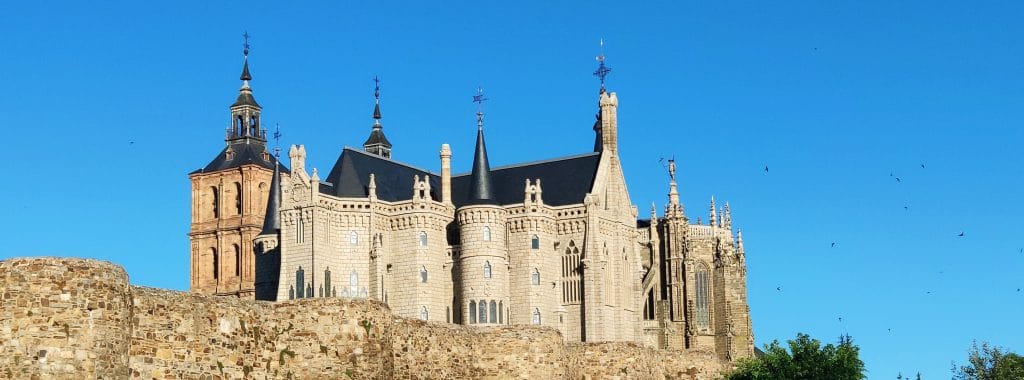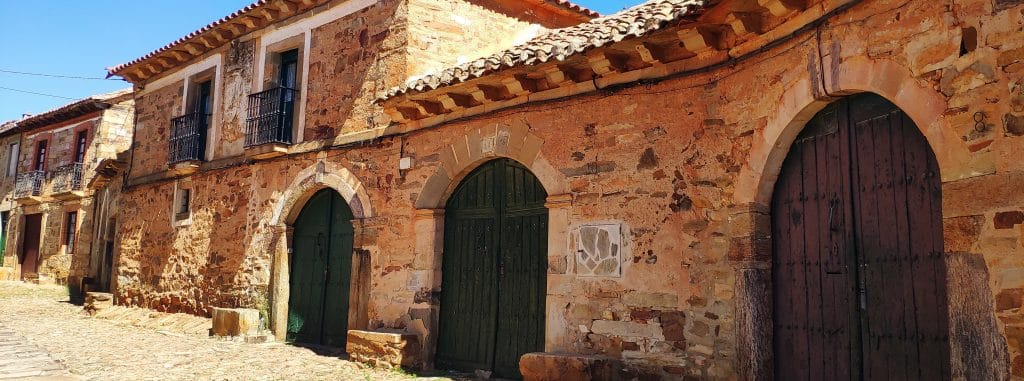Astorga was founded by Emperor Augustus, sacked by Almanzor and visited by a Napoleon worried about the fierce resistance that threatened his plans. The city is an open book that should be read slowly, strolling among historic buildings, getting lost in its museums and enjoying a gastronomy rich in products and nuances.
A crossroads for more than 2,000 years, hospitality is in Astorga’s DNA. The city has always coexisted with the traveller passing through, with the tourist, with the pilgrim, and has a wide gastronomic and cultural offer for the whole family. Do you want to know what to visit in Astorga? Read on.
1. Gaudí’s Palace
As chance would have it, Gaudí was the architect chosen to build the new Episcopal Palace in Astorga after the fire in the old palace, of which little or nothing is remembered. Gaudí’s design was meticulous, overseeing the most unsuspected details, such as the custom-made bricks to give shape to a project that was in many ways ahead of its time. Reproductions of some of these bricks can be found in the Palace shop.
The audio guides of the Palace, available in English, allow you to enjoy the visit independently and there are different versions: for adults, for families and for school groups. The visit to the Palace can last up to 90 minutes, although it will generally be shorter.

2. Astorga Cathedral
The Cathedral of Astorga was a work of centuries, as the different architectural and artistic styles that it combines with surprising harmony testify. Its naves, vaults and chapels are a good example of Gothic, the south façade being Renaissance; the main façade is the most outstanding work of the Leonese Baroque. The different colour of the towers is due to the fact that they were built several centuries apart, using a different stone on each occasion.
The interior of the Cathedral hides two jewels: the walnut choir, in Flemish style, and the high altarpiece (16th century), in polychrome wood, the work of Gaspar Becerra. The Cathedral Museum, dedicated to sacred art, has several unique pieces, such as the chest of San Genadio or the Chalice of Alonso de Portillo.
3. Plaza Mayor and Town Hall
The square Plaza Mayor of Astorga, with its arcades, is dominated by the Baroque façade of the Town Hall. The façade of the Town Hall is crowned by an automaton clock, on which the hours are struck by the figures of a couple of Maragatos (sometimes called Colás and Colasa, sometimes Colás and Zancuda). Time stops in the square at midday to enjoy this ephemeral spectacle that has been repeated every hour since 1748.
We are in the heart of Astorga, surrounded by cafés, restaurants, tapas bars, hotels and shops. Chocolate and cecina are on most visitors’ shopping lists, as are mantecadas, puff pastries and the excellent local sausages. Other local products that have won the hearts of those who know them are the handmade blankets from Val de San Lorenzo and the traditional Maragata goldsmith’s work, which can still be found in some local jewellers’ shops.
The Plaza Mayor is a good starting point for enjoying tapas in Astorga, which are served free with every drink. In the square itself and in the surrounding streets there are numerous bars where you can enjoy tapas, many of which are made with local produce.
4. Roman Astorga
The gold from Las Médulas led to a military camp on the edge of the empire becoming Asturica Augusta, one of the most prosperous cities in Hispania. The importance of the city and its strategic location in the northwest of the peninsula provided it with the best infrastructures: from the wall, which has survived to the present day, to the Roman sewers, part of which can be visited on the Roman Route. Among the Roman remains of the city, the Ergastula stands out, through which the Roman Museum can be accessed today. The route through the Astorga of Roman times also includes visits to two thermal complexes and the domus of the bear and the birds, where some beautiful mosaics have been preserved.
The Roman roads that reached Astorga from the east (Caesar Augusta, today Zaragoza) and from the south (Emerita Augusta, today Mérida) coincide for a large part of their route with two of the main pilgrimage routes to Santiago de Compostela, the French Way and the Silver Way.
5. Route through the Maragatería villages
The Maragatería is a unique region, with a landscape shaped 2,000 years ago by Roman open-cast mining, which used cuttings, mounds and artificial lakes to exploit the gold deposits in the area. It was on this unique landscape that the Maragatos settled, known and respected for centuries as muleteers. It was the mule-driving activity of many of its inhabitants that conditioned the architecture of the area, in which the houses were built around a large central courtyard with space for animals and carts.

What to see in Maragatería
- Maragatería villages: the traditional Maragatería house, sometimes converted into a rural hotel or restaurant, can be seen in villages such as Castrillo de los Polvazares, Santa Colomba de Somoza, Val de San Lorenzo, Santiago Millas and Rabanal del Camino.
- Singular buildings: each village has its own church and, sometimes, a hermitage. Among the churches are those of San Juan Bautista (Turienzo de los Caballeros) and San Juan Evangelista (Murias de Pedredo). The hermitage of Ecce Homo, at the foot of the Camino, in Valdeviejas and the hermitage dedicated to Nuestra Señora la Virgen de los Remedios, patron saint of Maragatería, in Luyego, are also of interest. Civil architecture, in addition to the numerous Maragatería houses, has bequeathed us the tower of the Osorio family, in an excellent state of conservation, in Turienzo de los Caballeros.
- The viewpoints allow the visitor to observe the Maragatería landscape with the necessary perspective to appreciate the Roman footprint. The best viewpoints in Maragatería are located in Pedredo (Pedredo viewpoint), in Santa Colomba de Somoza (Laguna Cernea viewpoint) and in Rabanal del Camino (Fucarona viewpoint).
- Hiking or cycling routes: there are different routes to explore Maragatería on foot or by bike. One of the most attractive starts between Lucillo and Filiel, signposted at the side of the road. After a short walk you will reach the so-called “petroglyphs of Teleno“, a 15-minute walk from where you can leave your car parked.
6. Chocolate Museum
The Chocolate Museum of Astorga was born as a private collection of objects related to the local chocolate industry. In 1994 José Luis López opened a modest exhibition that was soon overwhelmed by the curiosity of Astorga’s inhabitants and visitors. The City Council acquired the collection, made up of some 11,000 pieces, with the commitment to exhibit it in the best possible conditions.
Today, the Chocolate Museum is housed in a restored modernist mansion that belonged to a chocolate industrialist; its nine rooms exhibit around a quarter of the museum’s collection. One of the great virtues of this museum is that it gives a very precise idea of what the chocolate industry meant for Astorga in the first third of the 20th century, as it fostered numerous auxiliary activities: from workshops in which to manufacture and repair machinery, to printing works, in which some of the most coveted collections of advertising objects of the time were created.
The museum’s small shop allows you to taste and buy some of the chocolates that are still made in our region today.
7. What nobody tells you about Astorga
One of the best preserved civil buildings in the city is the Casa del Sacristán (17th century), opposite the Cathedral; it houses the most surprising exhibition that can be seen in Astorga, a real “cabinet of curiosities” in the 21st century.
There is a small window in the wall that joins the church of Santa Marta with the chapel of San Esteban, between Gaudí’s Palace and the Cathedral, which has gone unnoticed for years. A few steps lead up to the horror hidden within these four walls: the cell of the walled women.
On a pinnacle of the apse of the Cathedral you can see the statue of Pedro Mato, a Maragato about whom different legends circulate, but about whom nothing certain is known.
In the last few months we have missed the parades of Leonese banners that we used to see in some of our traditional celebrations. Astorga has a monument dedicated to this singular tradition; despite the initial controversy, the truth is that it has become one of the most Instagrammable corners of the city.

When Astorga’s walls became too small and the city began to grow, it did so mainly to the west, in what came to be known as Rectivía. The old church in the neighbourhood became too small when the houses gave way to blocks of flats, so it was completely demolished to build a modern church which opened its doors in 1972. It has some surprising elements of interest, such as its stained-glass windows and the mosaics on its façade, made by local residents.
We don’t usually think of breakfast when we talk about the gastronomy of Astorga, but I can’t think of a better way to start the day than the traditional chocolate a la taza, accompanied by mantecadas or some other local sweet. Chocolatería Sonrisas is a good place to try it.
The city has several parks and green areas, some of which are integrated into the historic centre, such as the Parque del Melgar or the Parque de la Sinagoga. Further away from the centre are the parks of La Eragudina and El Mayuelo. All of them have areas for rest and for strolling in the open air in spaces that are friendly for children.
Tips for your trip to Astorga
Some hotels have their own car park, which may be the most convenient option. If the accommodation does not have a car park or there are no parking spaces available, the best places to park in Astorga are:
- Melgar car park (Avenida de las Murallas, 11): large, free car park, less than 10 minutes’ walk from the main monuments, the shopping area and many of the hotels.
- Avenida de las Murallas: numerous free parking spaces within walking distance of the old town.
- Avenida de Ponferrada: this is the continuation of the previous one, moving away from the centre, but still very close to the city’s points of interest.
- Plaza de San Roque car park (Plaza de San Roque, 10): next to the old N-VI, at the foot of the wall, it is a large car park located very close to the Town Hall.
- City centre: there are few parking spaces and practically all of them are regulated parking spaces. The blue zone is payable from Monday to Friday in the morning and afternoon and on Saturday mornings. Parking in the blue zone is limited to a maximum of three hours in the same street.
Astorga also has a service and overnight stay area for motorhomes located in the vicinity of the bullring.
Where to eat a good Maragato stew?
Maragato stew is a hearty dish, served in three courses, typical of Maragatería, in León. Most restaurants in the city and the region serve it, but it is always advisable to make a reservation.
Casa Maragata has two restaurants in Astorga that serve only maragato stew; their dedication to this unique dish makes them a guarantee, although it is still advisable to book, as they tend to be full at weekends, long weekends and public holidays.
The best rated restaurants in Astorga, Serrano and La Peseta, also serve cocido maragato, although in the former only by order.

A few kilometres from Astorga, in Maragatería, there are several restaurants that offer a good maragato stew, generally in well-kept Maragatería mansions:
- Mesón Casa Lucinio, in Santiago Millas, 10 km away.
- Casa Pepa, in Santa Colomba de Somoza, 17 km away.
- La Venta de Goyo, in Valdespino de Somoza, 10 km away.
- Restaurant La Lechería, in Val de San Lorenzo, 8 km away.
- Entrepiedras Restaurant, in Castrillo de los Polvazares, 7 km away.
Where to stay in Astorga?
Astorga offers a wide variety of accommodation, from hotels with spa to tourist flats and rural houses, both in the city itself and throughout the region. Many of the establishments can be booked through the main portals in the sector, although in my experience it is always preferable to book directly with the accommodation. These are my suggestions for a relaxing stay in Astorga:
- Hotel Spa Ciudad de Astorga: four-star hotel located in Calle Los Sitios, very close to the Palace and the Cathedral.
- Hotel Astur Plaza: three-star hotel located in the Plaza Mayor.
- Casa Manuela: tourist flat (up to six people in three bedrooms).
- Hostería Camino: rural accommodation located in Luyego de Somoza, in the heart of Maragatería. Each room is unique and decorated with taste and care.
- Rural hotel La Lechería: located in Val de San Lorenzo.